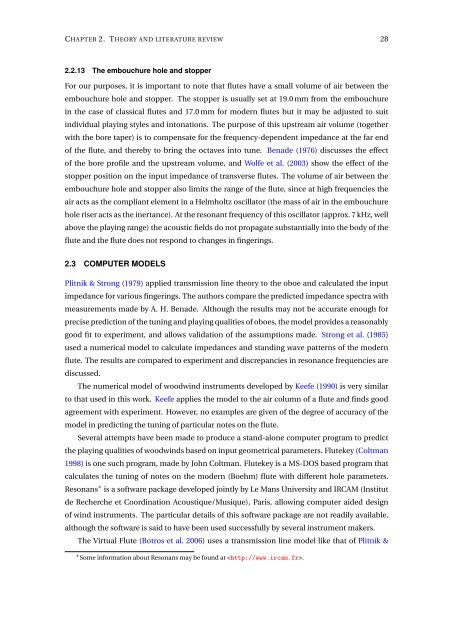Flute acoustics: measurement, modelling and design - School of ...
Flute acoustics: measurement, modelling and design - School of ...
Flute acoustics: measurement, modelling and design - School of ...
Create successful ePaper yourself
Turn your PDF publications into a flip-book with our unique Google optimized e-Paper software.
CHAPTER 2. THEORY AND LITERATURE REVIEW 28<br />
2.2.13 The embouchure hole <strong>and</strong> stopper<br />
For our purposes, it is important to note that flutes have a small volume <strong>of</strong> air between the<br />
embouchure hole <strong>and</strong> stopper. The stopper is usually set at 19.0 mm from the embouchure<br />
in the case <strong>of</strong> classical flutes <strong>and</strong> 17.0 mm for modern flutes but it may be adjusted to suit<br />
individual playing styles <strong>and</strong> intonations. The purpose <strong>of</strong> this upstream air volume (together<br />
with the bore taper) is to compensate for the frequency-dependent impedance at the far end<br />
<strong>of</strong> the flute, <strong>and</strong> thereby to bring the octaves into tune. Benade (1976) discusses the effect<br />
<strong>of</strong> the bore pr<strong>of</strong>ile <strong>and</strong> the upstream volume, <strong>and</strong> Wolfe et al. (2003) show the effect <strong>of</strong> the<br />
stopper position on the input impedance <strong>of</strong> transverse flutes. The volume <strong>of</strong> air between the<br />
embouchure hole <strong>and</strong> stopper also limits the range <strong>of</strong> the flute, since at high frequencies the<br />
air acts as the compliant element in a Helmholtz oscillator (the mass <strong>of</strong> air in the embouchure<br />
hole riser acts as the inertance). At the resonant frequency <strong>of</strong> this oscillator (approx. 7 kHz, well<br />
above the playing range) the acoustic fields do not propagate substantially into the body <strong>of</strong> the<br />
flute <strong>and</strong> the flute does not respond to changes in fingerings.<br />
2.3 COMPUTER MODELS<br />
Plitnik & Strong (1979) applied transmission line theory to the oboe <strong>and</strong> calculated the input<br />
impedance for various fingerings. The authors compare the predicted impedance spectra with<br />
<strong>measurement</strong>s made by A. H. Benade. Although the results may not be accurate enough for<br />
precise prediction <strong>of</strong> the tuning <strong>and</strong> playing qualities <strong>of</strong> oboes, the model provides a reasonably<br />
good fit to experiment, <strong>and</strong> allows validation <strong>of</strong> the assumptions made. Strong et al. (1985)<br />
used a numerical model to calculate impedances <strong>and</strong> st<strong>and</strong>ing wave patterns <strong>of</strong> the modern<br />
flute. The results are compared to experiment <strong>and</strong> discrepancies in resonance frequencies are<br />
discussed.<br />
The numerical model <strong>of</strong> woodwind instruments developed by Keefe (1990) is very similar<br />
to that used in this work. Keefe applies the model to the air column <strong>of</strong> a flute <strong>and</strong> finds good<br />
agreement with experiment. However, no examples are given <strong>of</strong> the degree <strong>of</strong> accuracy <strong>of</strong> the<br />
model in predicting the tuning <strong>of</strong> particular notes on the flute.<br />
Several attempts have been made to produce a st<strong>and</strong>-alone computer program to predict<br />
the playing qualities <strong>of</strong> woodwinds based on input geometrical parameters. <strong>Flute</strong>key (Coltman<br />
1998) is one such program, made by John Coltman. <strong>Flute</strong>key is a MS-DOS based program that<br />
calculates the tuning <strong>of</strong> notes on the modern (Boehm) flute with different hole parameters.<br />
Resonans ∗ is a s<strong>of</strong>tware package developed jointly by Le Mans University <strong>and</strong> IRCAM (Institut<br />
de Recherche et Coordination Acoustique/Musique), Paris, allowing computer aided <strong>design</strong><br />
<strong>of</strong> wind instruments. The particular details <strong>of</strong> this s<strong>of</strong>tware package are not readily available,<br />
although the s<strong>of</strong>tware is said to have been used successfully by several instrument makers.<br />
The Virtual <strong>Flute</strong> (Botros et al. 2006) uses a transmission line model like that <strong>of</strong> Plitnik &<br />
∗ Some information about Resonans may be found at .
















